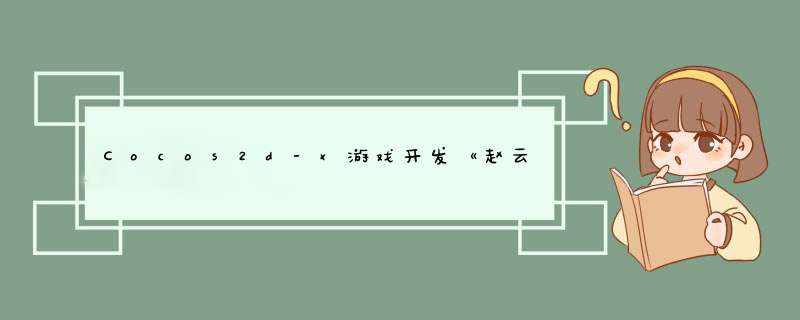
原文地址:http://cn.cocos2d-x.org/tutorial/show?id=2201
首先感谢作者Evankaka,再次感谢Cocos2dx官网的推荐,本人只是对作者引擎做些升级,以便Cocos2dx 3.3的用户学习吧
好吧,开始了,跟紧脚步啊,一起熟悉学习Cocos2dx 3.3吧
为了和原文一致,进度都是一样,let‘s go!!
本节内容是 Cocos2d-x虚拟摇杆控制精灵上下左右运动--之游戏《赵云要格斗》
首先,当然是创建工程了,我使用的引擎版本是Cocos2dx 3.3
一、创建游戏工程
1、下载Cocos2dx 3.3 ,并解压
2、点击目录下的setup.py,配置cocos路径,安卓的环境暂时没用到可以先不配
3、win + R打开cmd控制台,输入cocos,可以看到一堆的说明,哈哈,说明环境就Ok罗,
4、创建工程吧!! 控制台输入命令:cocos new Herofight -p com.chichi.Herofight -l cpp -d E:\WorkSpace\Herofight
Herofight 是游戏名 , -p是包名 ,-l是语言,这里是C++,-d是工程目录的路径
5、哈哈,目录出来了
二、修改背景图片和窗口大小
在AppDelegate中添加,代码中的红色部分即glvIEw->setFrameSize(640,480);
<span > // initialize director auto director = Director::getInstance(); auto glvIEw = director->getopenGLVIEw(); if(!glvIEw) { glvIEw = GLVIEwImpl::create("My Game"); </span><span >glvIEw->setFrameSize(640,480);</span><span > director->setopenGLVIEw(glvIEw); }</span> 然后在我们要显示的层上HelloWorldScene.cpp的init()函数添加:
Size visibleSize = Director::getInstance()->getVisibleSize(); Vec2 origin = Director::getInstance()->getVisibleOrigin(); auto sprite = Sprite::create("background_1.jpg"); sprite->setposition(Vec2(visibleSize.wIDth/2 + origin.x,visibleSize.height/2 + origin.y)); this->addChild(sprite,0); //摇杆 rocker = HRocker::createHRocker("Direction_bt.png","Direction_bc.png",Vec2(110,60)); this->addChild(rocker,2); rocker->startRoker(true); 效果图如下
三、添加虚拟摇杆
首先,先将摇杆素材放入到项目的Resources文件夹下,注意,最好把要用到的素材都放在这里,项目工程默认的素材是从此文件夹下查找。
这是摇杆的背景图片,图片不容易找啊。没有美工,只能随便网上找了点,
这是摇杆里面的按钮图片,它是可以移动的。
有了资源当然就可以定义一个摇杆类了,好吧,小伙伴接招吧!!新建一个HRocker.h的头文件,文件的主要实现如下:
#ifndef __HROCKER_H__#define __HROCKER_H__#include "cocos2d.h"using namespace cocos2d;//用于标识摇杆与摇杆的背景typedef enum { tag_rocker,tag_rockerBG}tagForHRocker;typedef enum { rocker_stay,rocker_right,rocker_up,rocker_left,rocker_down}tagDirection;class HRocker:public Layer{public: HRocker(); ~HRocker(); //创建摇杆(摇杆的 *** 作的图片资源名, 摇杆背景图片资源名,起始坐标) static HRocker* createHRocker(const char *rockerImagename,const char *rockerBGImagename,Vec2 position); //启动摇杆(显示摇杆、监听摇杆触摸事件) voID startRoker(bool _isstopOther); //通知摇杆(隐藏摇杆,取消摇杆的触屏监听) voID stopRocker(); //判断控制杆方向,用来判断精灵上、下、左、右运动 int rockerDirection; //当前人物行走方向,用来判断精灵的朝向,精灵脸朝右还是朝左 bool rockerRun; CREATE_FUNC(HRocker);private: //自定义初始化函数 voID rockerInit(const char *rockerImagename,Vec2 position); //是否可 *** 作摇杆 bool isCanMove; //获取当前摇杆与用户触屏点的角度 float geTrad(Vec2 pos1,Vec2 pos2); //摇杆背景坐标 Vec2 rockerBGposition; //摇杆背景半径 float rockerBGR; //触屏事件 bool ontouchBegan(touch *touch,Event *unused_event); voID ontouchmoved(touch *touch,Event *unused_event); voID ontouchended(touch *touch,Event *unused_event);};#endif 然后再创建HRocker.cpp,创建完成后要把 HRocker.cpp和 HRocker.h从proj.win32拷到classes文件中,代码如下:
#include "HRocker.h"const double PI = 3.1415;HRocker::HRocker(voID){ rockerRun = false;}HRocker::~HRocker(voID){}HRocker* HRocker::createHRocker(const char *rockerImagename,Vec2 position){ HRocker *layer = HRocker::create(); if (layer) { layer->rockerInit(rockerImagename,rockerBGImagename,position); return layer; } CC_SAFE_DELETE(layer); return NulL;}voID HRocker::rockerInit(const char *rockerImagename,Vec2 position){ auto spRokerBG = Sprite::create(rockerBGImagename); spRokerBG->setposition(position); spRokerBG->setVisible(false); addChild(spRokerBG,tag_rockerBG); auto spRoker = Sprite::create(rockerImagename); spRoker->setposition(position); spRoker->setVisible(false); addChild(spRoker,1,tag_rocker); rockerBGposition = position; rockerBGR = spRokerBG->getContentSize().wIDth * 0.5; rockerDirection = -1;}voID HRocker::startRoker(bool _isstopOther){ auto rocker = (Sprite*)this->getChildByTag(tag_rocker); rocker->setVisible(true); auto rockerBG = (Sprite*)this->getChildByTag(tag_rockerBG); rockerBG->setVisible(true); auto touchListener = EventListenertouchOneByOne::create(); touchListener->setSwallowtouches(true); touchListener->ontouchBegan = CC_CALLBACK_2(HRocker::ontouchBegan,this); touchListener->ontouchmoved = CC_CALLBACK_2(HRocker::ontouchmoved,this); touchListener->ontouchended = CC_CALLBACK_2(HRocker::ontouchended,this); _eventdispatcher->addEventListenerWithSceneGraPHPriority(touchListener,this);}voID HRocker::stopRocker(){ auto rocker = (Sprite*)this->getChildByTag(tag_rocker); rocker->setVisible(false); auto rockerBG = (Sprite*)this->getChildByTag(tag_rockerBG); rockerBG->setVisible(false); _eventdispatcher->removeEventListenersForTarget(this);}float HRocker::geTrad(Vec2 pos1,Vec2 pos2){ float px1 = pos1.x; float py1 = pos1.y; float px2 = pos2.x; float py2 = pos2.y; //得到两点x的距离 float x = px2 - px1; //得到两点y的距离 float y = py2 - py1; //算出斜边长度 float xIE = sqrt(pow(x,2) + pow(y,2)); //算出这个角的余弦值(通过三角函数中的定理:角度余弦值 = 邻边 / 斜边) float cosAngle = x / xIE; //通过反余弦定理获取到角度的弧度 float rad = acos(cosAngle); //注意:当触屏的位置Y坐标<摇杆的Y坐标,我们要取反值-0 ~ -180 if (py2 < py1) { rad = -rad; } return rad;}Vec2 getAngleposition(float r,float angle){ return Vec2(r*cos(angle),r*sin(angle));}bool HRocker::ontouchBegan(touch *touch,Event *unused_event){ Vec2 point = touch->getLocation(); auto rocker= (Sprite *)this->getChildByTag(tag_rocker); if (rocker->getBoundingBox().containsPoint(point)) { isCanMove = true; cclOG("begin"); } return true;}voID HRocker::ontouchmoved(touch *touch,Event *unused_event){ if (!isCanMove) { return; } Vec2 point = touch->getLocation(); auto rocker= (Sprite*)this->getChildByTag(tag_rocker); //得到摇杆与触屏点所形成的角度 float angle = geTrad(rockerBGposition,point); //判断两个圆的圆心距是否大于摇杆背景的半径 if (sqrt(pow(rockerBGposition.x - point.x,2) + pow(rockerBGposition.y - point.y,2)) >= rockerBGR) { rocker->setposition(ccpAdd(getAngleposition(rockerBGR,angle),rockerBGposition)); } else { //当没有超过,让摇杆跟随用户触屏点移动即可 rocker->setposition(point); } //判断方向 if (angle >= -PI/4 && angle < PI/4) { rockerDirection = rocker_right; rockerRun = false; } else if(angle >= PI/4 && angle < 3*PI/4) { rockerDirection = rocker_up; } else if((angle >= 3*PI/4 && angle <= PI) || angle >= -PI && angle < -3*PI/4) { rockerDirection = rocker_left; rockerRun = true; } else if (angle >= -3*PI/4 && angle < -PI/4) { rockerDirection = rocker_down; }}voID HRocker::ontouchended(touch *touch,Event *unused_event){ if (!isCanMove) { return; } auto rockerBG = (Sprite *)this->getChildByTag(tag_rockerBG); auto rocker = (Sprite *)this->getChildByTag(tag_rocker); rocker->stopAllActions(); rocker->runAction(CCMoveto::create(0.08f,rockerBGposition)); isCanMove = false; rockerDirection = rocker_stay;} 哈哈,注释很多,慢慢理解
现在添加HRocker摇杆,打开HelloWorldScene.h添加头文件#include "HRocker.h",加入摇杆类的成员变量
private: HRocker *rocker;
在HelloWorldScene.cpp的init()函数添加代码如下:
//摇杆 rocker = HRocker::createHRocker("Direction_bt.png",2); rocker->startRoker(true); 效果如下:
四、添加精灵并用摇杆控制’赵云移动‘,激动吧!!!!!!(*^__^*) ~~
这里创建赵云走路的动画,我就顺作者的了,主要就是赵云序列帧用TexturePacker打包图片在一张图片上
这里为了能让精灵运行,我自己创建了一个类Hero,它继承了CCNode,里面实现了动画播放和停止。
赵云的走的动作其实就是一系列的图片合成在一起,
另外,赵云不运动时的图片为这是不运动时精灵的贴图图片。
这里我为了省事,直接用工具TexturePacker将它们打包生成相应的png和pList,这两个合起来在Cocos2d-x可以组成一个动画,比较省事
命名为run_animation.png和run_animation.pList,然后还是把它们放在项目的Resources文件夹下
为了让代码更加容易理解些,我自己创建了一个类,Hero,它继承了CCNode,并且里面有一成员变量 CCSprite* m_HeroSprite;我们就是通过控制它的动画来实现运动的。里面实现了动画播放和停止,好了,代码如下:
#ifndef __HERO_H__#define __HERO_H__#include "cocos2d.h"using namespace cocos2d;class Hero:public Layer{public: Hero(); ~Hero(); //根据图片创建英雄 voID InitHeroSprite(char *hero_name); //设置动画,num为图片数目, run_direction为精灵脸朝向,false朝右, name_each为name——png中的每一小张图片的公共名称部分 voID SetAnnimation(const char *name_pList,const char *name_png,const char *name_each,const unsigned int num,bool run_direction); //停止动画 voID StopAnimation(); //判断是否在跑动画 bool IsRunning; //英雄运动方向 bool HeroDirection; CREATE_FUNC(Hero);private: //精灵 Sprite *m_HeroSprite; //用来保存初始状态的精灵图片名称 char *Hero_name;};#endif //__HERO_H__ Hero.cpp实现如下:
#include "Hero.h"USING_NS_CC;Hero::Hero(){ IsRunning = false; HeroDirection = false; Hero_name = NulL;}Hero::~Hero(){}voID Hero::InitHeroSprite(char *hero_name){ Hero_name = hero_name; this->m_HeroSprite = Sprite::create(hero_name); this->addChild(m_HeroSprite);} //动画播放,可以是跑、攻击、死亡、受伤等voID Hero::SetAnnimation(const char *name_pList,bool run_direction){ if (HeroDirection != run_direction) { HeroDirection = run_direction; m_HeroSprite->setFlippedX(run_direction); } if (IsRunning) return; //将图片加载到精灵帧缓存池 SpriteFrameCache *m_frameCache = SpriteFrameCache::getInstance(); m_frameCache->addSpriteFramesWithfile(name_pList,name_png); //用一个列表保存所有的CCSpriteFrameCache Vector<SpriteFrame*> frameArray; unsigned int i; for (i=2; i<=num; i++) { SpriteFrame *frame = m_frameCache->getSpriteFrameByname(__String::createWithFormat("%s%d.png",name_each,i)->getCString()); frameArray.pushBack(frame); } //使用列表创建动画对象 Animation *animation = Animation::createWithSpriteFrames(frameArray); if (HeroDirection != run_direction) { HeroDirection = run_direction; } //表示无限循环播放 animation->setLoops(-1); //每两张图片的时间隔,图片数目越少,间隔最小就越小 animation->setDelayPerUnit(0.1f); //将动画包装成一个动作 Animate *animate = Animate::create(animation); m_HeroSprite->runAction(animate); IsRunning = true;}voID Hero::StopAnimation(){ if (!IsRunning) { return; } m_HeroSprite->stopAllActions(); //恢复精灵原来的初始化贴图 //把原来的精灵删除掉 this->removeChild(m_HeroSprite,true); //恢复精灵原来的贴图样子 m_HeroSprite=CCSprite::create(Hero_name);//恢复精灵原来的贴图样子 m_HeroSprite->setFlippedX(HeroDirection); this->addChild(m_HeroSprite); IsRunning=false;} 在HelloWorldScene.h 添加头文件#include "Hero.h",并加入成员变量
private: Hero *hero;
在HelloWorldScene.h的init()函数添加:
//添加赵云精灵hero=Hero::create();hero->InitHeroSprite("zhoayun.png");hero->setposition(ccp(200,200));this->addChild(hero,1); 效果如下:
这时图片还是静止的为了要验证一个精灵的运动,我们来播放一个它的走动的动画,在上面
//英雄 hero = Hero::create(); hero->InitHeroSprite("zhoayun.png"); hero->setposition(Vec2(200,200)); this->addChild(hero,1); hero->SetAnnimation("run_animation.pList","run_animation.png","run_",8,true); 测试新代码哈哈,这是面朝左的哦,同理朝右为false哦,上图
朝右的我就不上图了。。。
测试完成,我们把这句话去掉吧
//hero->SetAnnimation("run_animation.pList",true); 我们让摇杆让赵云动起来吧,激动吧(*^__^*) ~~
什么动起来,好像很高大上啊,其实就是播放动画的时候播移动精灵的位置,当然也要判断赵云的脸朝向,上面的摇杆类HRocker中
//判断控制杆方向,用来判断精灵上、下、左、右运动 int rockerDirection; //当前人物行走方向,用来判断精灵的朝向,精灵脸朝右还是朝左 bool rockerRun;
我们只要将这两个参数传给赵云的英雄类的Hero中
//动画播放,可以是跑、攻击、死亡、受伤等voID Hero::SetAnnimation(const char *name_pList,bool run_direction)
如上的函数里的一个是bool类型,这是精灵的朝向,哈哈刚好用HRocker中的朝向
前面在HelloWorldScene.h中不是创建两个对象
private: Hero *hero; HRocker *rocker;
voID update(float delta);
此时要在英雄创建的后面开启定时器
<span > </span>//英雄 hero = Hero::create(); hero->InitHeroSprite("zhoayun.png"); hero->setposition(Vec2(200,true); this->scheduleUpdate(); 哈哈,然后实现update函数里面的方法就行了
voID HelloWorld::update(float delta){ switch (rocker->rockerDirection) { case 1: hero->SetAnnimation("run_animation.pList",rocker->rockerRun); hero->setposition(Vec2(hero->getpositionX()+1,hero->getpositionY())); break; case 2: hero->SetAnnimation("run_animation.pList",rocker->rockerRun); hero->setposition(Vec2(hero->getpositionX(),hero->getpositionY() + 1)); break; case 3: hero->SetAnnimation("run_animation.pList",rocker->rockerRun); hero->setposition(Vec2(hero->getpositionX()-1,hero->getpositionY())); break; case 4: hero->SetAnnimation("run_animation.pList",hero->getpositionY() - 1)); break; default: hero->StopAnimation(); break; }} 到此我们run一下吧,哈哈,赵云动起来了,但是还比较傻,后面章节将更加有趣!!
好了到此第一章就结束了!!
总结以上是内存溢出为你收集整理的Cocos2d-x游戏开发《赵云要格斗》 (一) cocos2dx3.3全部内容,希望文章能够帮你解决Cocos2d-x游戏开发《赵云要格斗》 (一) cocos2dx3.3所遇到的程序开发问题。
如果觉得内存溢出网站内容还不错,欢迎将内存溢出网站推荐给程序员好友。
欢迎分享,转载请注明来源:内存溢出

 微信扫一扫
微信扫一扫
 支付宝扫一扫
支付宝扫一扫
评论列表(0条)